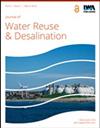住宅灌溉中水的微生物和化学风险
IF 2.3
Q2 Environmental Science
引用次数: 8
摘要
干旱和半干旱地区越来越多地利用非传统灌溉水,包括再生废水。通过测试蓄水池、配水管线和家用龙头水(n=190)以及从5个家庭花园收获的14种蔬菜和水果(n=90)中的7种水传播病原体、47种抗生素抗性基因和12种药品和个人护理产品,确定了与回收废水使用相关的人类健康风险。根据居民对再生废水使用情况的调查,建立了两种暴露途径的模型:水果和蔬菜灌溉和灌溉软管饮用。概率定量微生物风险评估表明,由于腺病毒和肠球菌,生蔬菜和水果的食用量超过了0.015的基准患病率。化学风险评估表明,在家庭自来水中检测到的10种PPCP中,每天需要消耗数吨蔬菜和数亿加仑水才能达到不可接受的风险,这表明PPCP的风险很小。在水样和作物中检测到八个不同的耐药性基因家族,这表明用含有药物的再生水灌溉的食物中存在抗生素耐药性生物。这些结果阐明了来自再生废水灌溉的病原体和PPCP的综合风险。本文章由计算机程序翻译,如有差异,请以英文原文为准。
Microbial and chemical risk from reclaimed water use for residential irrigation
Arid and semi-arid locations are increasingly utilizing nontraditional irrigation water including reclaimed wastewater. Human health risk associated with reclaimed wastewater use was determined by testing reservoir, distribution line and home spigot water (n=190) and 14 types of vegetables and fruits (n=90) harvested from 5 home gardens for 7 waterborne pathogens, 47 antibiotic resistance genes and 12 pharmaceuticals and personal care products (PPCPs). Based on surveys of the residents’ use of the reclaimed wastewater, two exposure routes were modeled: irrigation of fruits and vegetables and drinking from irrigation hoses. Probabilistic quantitative microbial risk assessment indicated that consumption of raw vegetables and fruits exceeded a 0.015 benchmark illness rate due to adenovirus and enterococci. Chemical risk assessments indicated that consumption of tons of vegetables per day and hundreds to millions of gallons of water per day would be needed to reach an unacceptable risk among the 10 PPCPs detected in home spigot water, indicating de minimis risk from PPCPs. Eight different drug resistance gene families were detected in the water samples and crops indicating that antibiotic-resistant organisms are present on foods irrigated with reclaimed water containing pharmaceuticals. These results elucidate the combined risk from pathogens and PPCPs from reclaimed wastewater irrigation.
求助全文
通过发布文献求助,成功后即可免费获取论文全文。
去求助
来源期刊

Journal of Water Reuse and Desalination
ENGINEERING, ENVIRONMENTAL-WATER RESOURCES
CiteScore
4.30
自引率
0.00%
发文量
23
审稿时长
16 weeks
期刊介绍:
Journal of Water Reuse and Desalination publishes refereed review articles, theoretical and experimental research papers, new findings and issues of unplanned and planned reuse. The journal welcomes contributions from developing and developed countries.
 求助内容:
求助内容: 应助结果提醒方式:
应助结果提醒方式:


